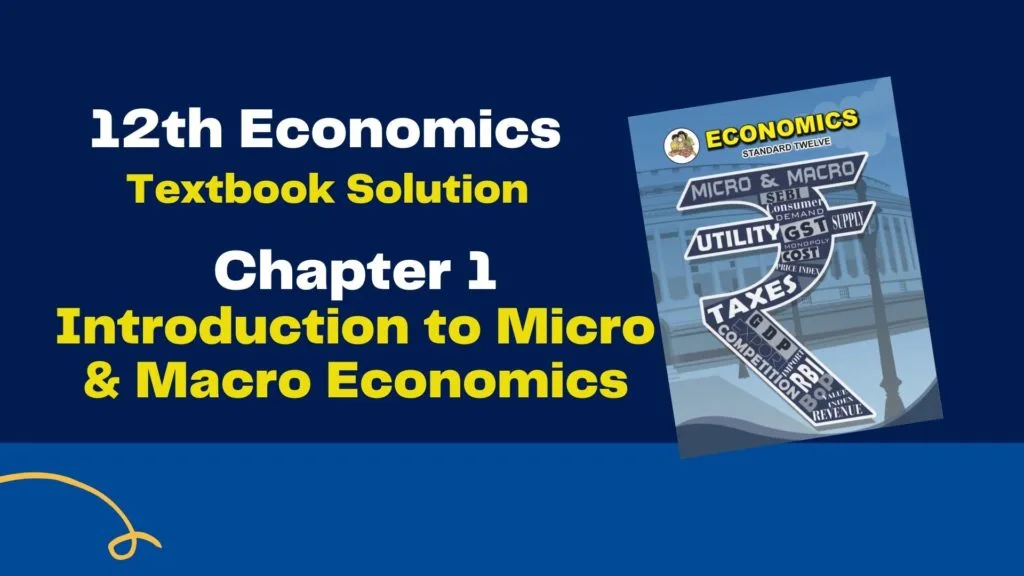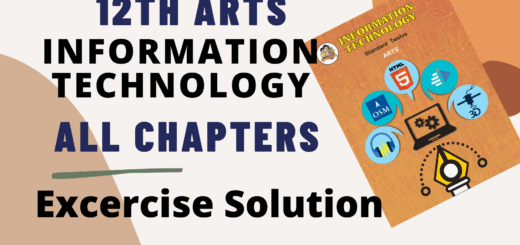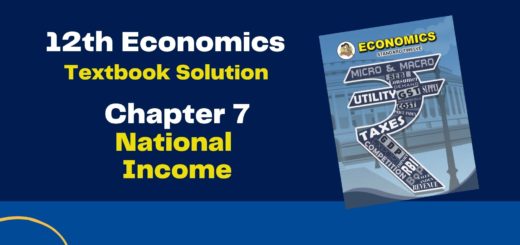12th Commerce Economics Chapter 1 (Introduction to Micro Economics and Macro Economics) Maharashtra Board – Free Solution
Table of Contents
12th Commerce Economics Chapter 1

Chapter 1
Introduction to Micro Economics and Macro Economics
Q. 1. Choose the correct option
1) The branch of economics that deals with the allocation of resources.
a) Microeconomics
b) Macroeconomics
c) Econometrics
d) None of these
Options :
1) a, b, and c
2) a and b
3) only a
4) None of these
2)Concepts studied under Microeconomics.
a) National income
b) General price level
c) Factor pricing
d) Product pricing
Options :
1) b and c
2) b, c, and d
3) a, b and c
4) c and d
3) Method adopted in microeconomic analysis.
a) Lumping method
b) Aggregative method
c) Slicing method
d) Inclusive method
Options :
1) a, c and d
2) a, b and d
3) only c
4) only a
4) Concepts studied under Macroeconomics.
a) Whole economy
b) Economic development
c) Aggregate supply
d) Product pricing
Options :
1) a, b, and c
2) b, c, and d
3) only d
4) a, b, c, and d
Q. 2. Complete the correlation
1) Micro economics : Slicing method : : Macro economics : Lumping Method
2) Micro economics : Tree : : Macro economics : Forest
3) Macro economic theory : Income and employment : : Micro economics : Theory of pricing
4) Makros : Macro economics : : Mikros : Micro Economics
5) General equilibrium : Macro economics :: Micro economics : Partial Equilibrium
Q. 3. Identify and explain the concepts from the given illustrations
1) Gauri collected information about the income of a particular firm.
Identified Concept: Study of individual economic units.
Explanation: Microeconomics is the study of the behaviour of small individual economic units, like an individual firm, individual price, individual household, etc.
2) Ramesh decided to take all decisions related to production, such as what and how to produce?
Identified Concept: Business Decision in a free market economy.
Explanation: Microeconomic theories are helpful to businessmen for taking crucial business decisions. These
decisions are related to the determination of cost of production, determination of prices of goods, maximization of output and profit, etc.
3) Shabana paid wages to workers in her factory and interest on her bank loan.
Identified Concept: Payment of factor price/reward.
Explanation: In Microeconomics, land, labour, capital and entrepreneur are the factors that contribute to the production process. Microeconomics helps in determining the factor rewards for land, labour, capital, and entrepreneur in the form of rent, wages, interest, and profit respectively.
Solution of other subjects
Solution of all Chapters of Economics
1 – 2 – 3A – 3B – 4 – 5 – 6 – 7 – 8 – 9 – 10
Q. 4. Answer the following
1) Explain the features of Microeconomics.
Answer:
“Microeconomics is in fact a microscopic study of the economy.”
Features of Microeconomics:
1) Study of Individual Units:
Microeconomics is the study of the behaviour of small individual economic units, such as an individual firm, individual price, individual household, etc.
2) Price Theory:
Microeconomics deals with the determination of the prices of goods and services as well as factors of production. Hence, it is known as price theory.
3) Partial Equilibrium:
Equilibrium is the balance between two factors. Microeconomic analysis deals with partial equilibrium which analyses the equilibrium position of an individual economic unit i.e. individual consumer, individual firm, individual industry etc.
4) Based on Certain Assumptions:
Microeconomics begins with the fundamental assumption, “Other things remaining constant” (Ceteris Paribus) such as perfect competition, laissez-faire policy, pure capitalism, full employment, etc. These assumptions make the analysis simple.
5) Slicing Method:
Microeconomics uses the slicing method. It splits or divides the whole economy into small individual units and then studies each unit separately in detail. For example, study of individual income out of national income, study of individual demand out of aggregate demand, etc.
6) Use of Marginalism Principle:
The concept of Marginalism is the key tool of microeconomic analysis. The term ‘marginal’ means change brought in total by an additional unit. Marginal analysis helps to study a variable through the changes. Producers and consumers make economic decisions using this principle.
7) Analysis of Market Structure:
Microeconomics analyses different market structures such as Perfect Competition, Monopoly, Monopolistic Competition, Oligopoly etc.
8) Limited Scope:
The scope of microeconomics is limited to only individual units. It doesn’t deal with nationwide economic problems such as inflation, deflation, balance of payments, poverty, unemployment, population, economic growth etc.
2) Explain the importance of Macroeconomics.
Answer: “Macroeconomics is that branch of economics which considers the relationship between large aggregates such as the volume of employment, total amount of savings, investment, national income, etc.”
Importance of Macro Economics:
1) Functioning of an Economy:
Macroeconomic analysis gives us an idea of the functioning of an economic system. It helps us to understand the behaviour pattern of aggregative variables in a large and complex economic system.
2) Economic Fluctuations:
Macroeconomics helps to analyze the causes of fluctuations in income, output, and employment and attempts to control them or reduce their severity.
3) National Income:
The study of macroeconomics has brought forward the immense importance of the study of national income and social accounts. Without a study of national income, it is not possible to formulate correct economic policies.
4) Economic Development:
Advanced studies in macroeconomics help to understand the problems of developing countries such as poverty, inequalities of income and wealth, differences in the standards of living of the people etc. It suggests important steps to achieve economic development.
5) Performance of an Economy:
Macroeconomics helps us to analyse the performance of an economy. National Income (NI) estimates are used to measure the performance of an economy over time by comparing the production of goods and services in one period with that of the other period.
6) Study of Macroeconomic Variables:
To understand the working of the economy, the study of macroeconomic variables are important. Main economic problems are related to the economic variables such as behaviour of total income, output, employment and general price level in the economy.
7) Level of Employment:
Macroeconomics helps to analyse the general level of employment and output in an economy.
3) Explain the scope of Macroeconomics.
Answer: “Macroeconomics deals with the functioning of the economy as a whole.”
Scope of Macroeconomics:
1) Theory of Income and Employment:
Macroeconomic analysis explains which factors determine the level of national income and employment and what causes fluctuations in the level of income, output, and employment. To understand, how the level of employment is determined, we have to study the consumption function and investment function. The theory of Business Cycles is also a part and parcel of the Theory of Income and Employment.
2) Theory of General Price Level and Inflation:
Macroeconomic analysis shows how the general price level is determined and further explains what causes fluctuations in it. The study of general price level is significant on account of the problems created by inflation and deflation.
3) Theory of Growth and Development:
Macroeconomics consists of the theory of economic growth and development. It explains the causes of underdevelopment and poverty. It also suggests strategies for accelerating growth and development.
4) Macro Theory of Distribution:
The macro theory of distribution deals with the relative shares of rent, wages, interest and profit in the total national income.
Q. 5. State with reasons whether you agree or disagree with the following statements
1) The scope of microeconomics is unlimited.
Ans: No, I disagree with this statement.
Reason: a) The term ‘micro’ is derived from the Greek word, ‘Mikros’ which means small or a millionth part.
b) It studies the economic actions and behaviour of individual units such as an individual consumer, individual producer or a firm, the price of a particular commodity or a factor, etc.
c) The scope of microeconomics is limited to only individual units. It doesn’t deal with the nationwide
economic problems such as inflation, deflation, balance of payments, poverty, unemployment, population, economic growth etc.
Therefore, the scope of microeconomics is not unlimited but is limited.
2) Macroeconomics deals with the study of individual behaviour.
Ans: No, I disagree with this statement.
Reason: a) Macroeconomics does not study the individual economic unit such as particular consumer, individual firm, individual industry, etc.
b) Macroeconomics deals with the total employment, national income, national output, total investment, total consumption, total savings, general price level interest rates, inflation, trade cycles, business fluctuations etc. Thus, macroeconomics is the study of aggregates.
c) Macroeconomics deals with the study of economy as a whole. It is concerned with aggregate concepts such as national income, national output, national employment, general price level, business cycles, etc.
Thus, macroeconomics deals with the study of behaviour and aggregates.
3) Macroeconomics is different from microeconomics.
Ans: Yes, I agree with this statement.
Reason: a) Macroeconomics is the study of entire economy. On the other hand, microeconomics is a study of a particular segment of an economy.
b) Macroeconomics studies aggregate demand, aggregate supply, national income, employment, etc. While microeconomics studies individual units such as individual demand, individual supply, and Price determination of product.
c) Macroeconomics follows general equilibrium analysis. While microeconomics follows partial equilibrium analysis.
d) Macroeconomics uses a lumping method. On the other hand, microeconomics uses the slicing method.
Therefore, Macroeconomics is different from microeconomics.
4) Microeconomics uses slicing method.
Ans: Yes, I agree with this statement.
Reason: a) Microeconomics is the study of the behaviour of small individual economic units, like
an individual firm, individual price, individual household etc.
b) Microeconomics uses slicing method. It splits or divides the whole economy into small individual units and then studies each unit separately in detail.
c) For example, study of individual income out of national income, study of individual demand out of aggregate demand etc.
Thus, macroeconomics uses slicing method.
5) Microeconomics is known as Income theory.
Ans: No, I disagree with this statement.
Reason: a) Income Theory lies within the scope of macroeconomics.
b) Microeconomics deals with the price determination of goods and services. Thus the theory of demand, supply, etc falls within the scope of microeconomics.
c) In microeconomics land, labour, capital and entrepreneur are the factors that contribute to the production process. Microeconomics helps in determining the factor rewards for land, labour, capital, and entrepreneur in the form of rent, wages, interest, and profit respectively.
Thus, Microeconomics is not known as Income Theory but is known as Price Theory.
Solution of other subjects
Solution of all Chapters of Economics
1 – 2 – 3A – 3B – 4 – 5 – 6 – 7 – 8 – 9 – 10
Q. 6. Answer in detail
1) Explain the importance of Microeconomics.
Answer: Micro means a small part of a thing. Microeconomics thus deals with a small part of the national economy.
Definitions of Micro Economics: Maurice Dobb – “Microeconomics is in fact a microscopic study of the economy.”
Importance of Micro Economics:
i) Price Determination:
Microeconomics explains how the prices of different products and various factors of production are determined.
ii) Free Market Economy:
Microeconomics helps in understanding the working of a free market economy. A free-market economy is that economy where the economic decisions regarding the production of goods, such as ‘What to produce?, How much to produce?, How to produce? etc.’ are taken at individual levels. There is no intervention by the Government or any other agency.
iii) Foreign Trade:
Microeconomics helps in explaining various aspects of foreign trade like effects of a tariff on a particular commodity, determination of currency exchange rates of any two countries, gains from international trade to a particular country, etc.
iv) Economic Model Building:
Microeconomics helps in understanding various complex economic situations with the help of economic models. It has made a valuable contribution to economics by developing various terms, concepts, terminologies, tools of economic analysis, etc. Economic models are built using various economic variables.
v) Business Decisions:
Microeconomic theories are helpful to businessmen for taking crucial business decisions. These decisions are related to the determination of cost of production, determination of
prices of goods, maximization of output and profit, etc.
vi) Useful to Government:
It is useful to the government in framing economic policies such as taxation policy, public expenditure policy, price policy, etc. These policies help the government to attain its goals of efficient allocation of resources and promoting economic welfare of the society.
vii) Basis of Welfare Economics:
Microeconomics explains how best results can be obtained through optimum utilization of resources and its best allocation. It also studies how taxes affect social welfare.
Thus, microeconomics has many theoretical and practical importance as well as uses.
2) Explain the concept of Macroeconomics and its features.
Answer:
Macroeconomics is the branch of economics that analyses the entire economy. It deals with the total employment, national income, national output, total investment, total consumption, total savings, general price level interest rates, inflation, trade cycles, business fluctuations, etc. Thus, macroeconomics is the study of aggregates.
Following are the features of macroeconomics.
i) Study of Aggregates
Macroeconomics deals with the study of economy as a whole. It is concerned with aggregate concepts such as national income, national output, national employment, general price level, business cycles etc.
ii) Income Theory
Macroeconomics studies the concept of national income, its different elements, methods of measurement, and social accounting. Macroeconomics deals with aggregate demand and aggregate supply. It explains the causes of fluctuations in the national income that lead to business cycles i.e. inflation and deflation.
iii) General Equilibrium Analysis
Macroeconomics deals with the behaviour of large aggregates and their functional relationship. General Equilibrium deals with the behaviour of demand, supply and prices in the whole economy.
iv) Interdependence
Macro analysis takes into account interdependence between aggregate economic variables, such as income, output, employment, investments, price level etc. For example, changes in the level of investment will finally result into changes in the levels of income, levels of output, employment, and eventually the level of economic growth.
v) Lumping Method
The lumping method is the study of the whole economy rather than its part. According to Prof. Boulding, “Forest is an aggregation of trees but it does not reveal the properties of an individual tree.” This reveals the difference between microeconomics and macroeconomics.
vi) Growth Models
Macroeconomics studies various factors that contribute to economic growth and development. It is useful in developing growth models. These growth models are used for studying economic development. For example, Mahalanobis growth model emphasized on basic heavy industries.
vii) General Price Level
Determination and changes in general price level are studied in macroeconomics. The general price level is the average of all prices of goods and services currently being produced in the economy.
viii) Policy-oriented
According to Keynes, macroeconomics is a policy-oriented science. It suggests suitable economic policies to promote economic growth, generate employment, control of inflation, and depression, etc.
Thus, microeconomics has many theoretical and practical importance as well as uses.
Extra Questions
1) Explain the Scope of Microeconomics.
Answer: Micro means a small part of a thing. Microeconomics thus deals with a small part of the national economy.
Definitions of Micro Economics: Maurice Dobb – “Microeconomics is in fact a microscopic study of the economy.”
Scope of Micro Economics
(a) Theory of Product Pricing
The price of an individual commodity is determined by the market forces of demand and supply. Micro economics is concerned with demand analysis i.e. individual consumer behaviour, and supply analysis i.e. individual producer behaviour.
(b) Theory of Factor Pricing
In Microeconomics, land, labour, capital and entrepreneur are the factors that contribute to the production process. Microeconomics helps in determining the factor rewards for land, labour, capital, and entrepreneur in the form of rent, wages, interest, and profit respectively.
(c) Theory of Economic Welfare
The theory of Welfare basically deals with efficiency in the allocation of resources. Efficiency in the allocation of resources is attained when it results in maximization of satisfaction of the people. Economic efficiency involves three efficiencies
• Efficiency in production: Efficiency in production means producing maximum possible amount of goods and services from the given amount of resources.
• Efficiency in consumption: Efficiency in consumption means distribution of produced goods and services among the people for consumption in such a way as to maximize total satisfaction of the society.
• Overall economic efficiency : It means the production of those goods which are most desired by the people.
Thus, the focus of microeconomics is mainly confined to price theory and resource allocation. It does not study the aggregates relating to the whole economy.
2)Write in brief about the historical review of Microeconomics.
Answer:
Following is the historical review of Micro Economics :
a) Micro means a small part of a thing. Microeconomics thus deals with a small part of the national economy.
b) Microeconomic analysis was developed first. It is a traditional approach.
c) Origin of this approach can be traced back to the era of Classical Economists- Adam Smith, David Ricardo, J. S. Mill etc.
d) It was popularized by Neo-Classical Economist, Prof. Alfred Marshall in his book, ‘Principles of Economics’, published in 1890.
e) Other economists like Prof. Pigou, J. R. Hicks, Prof. Samuelson, Mrs. Joan Robinson, etc. have also contributed to the development of Micro Economics.
3)Write in brief about the historical review of Macroeconomics.
Answer:
Following is the historical review of Macro Economics :
a) Macroeconomics is the branch of economics that analyses the entire economy. It deals with the total employment, national income, national output, total investment, total consumption, total savings, general price level interest rates, inflation, trade cycles, business fluctuations, etc. Thus, macroeconomics is the study of aggregates.
a) Macroeconomics did exist in the past before the evolution of microeconomics.
b) In the 16th and 17th century, followers of Mercantilists (a group of English merchants) advocated policies to the government which were based on macro approach.
c) In the 18th century, Physiocrats (French Thinkers) tried to analyse the concept of national income and wealth.
d) Even the Classical Economic theories of Prof. Adam Smith, Prof. Ricardo and Prof. J. S. Mill discussed the determination of national income and wealth.
e) But their macro analysis was combined with microanalysis. Thus, microanalysis ruled the world of economics till the Great Depression of 1930s.
f) After the Great Depression, Lord John Maynard Keynes published his famous book the “General Theory of Employment, Interest and Money” in 1936. Keynes used macroeconomic approch to analyse economic problems. The credit for the development of macroeconomic approach goes to Lord Keynes.
g) Besides Keynes, Malthus, Wicksell, Walras, and Irving Fisher are other economists who have contributed to the development of macroeconomics.
4) Distinguish Between: Slicing method and lumping method.
Answer:
| Slicing method | lumping method |
| It splits or divides the whole economy into small individual units and then studies each unit separately in detail. | Lumping method is the study of the whole economy rather than its part. |
| Macroeconomics uses lumping method. | Macro economics uses lumping method. |
12th Economics Textbook Solutions
| Chapter Name | Solution Link |
| 1) Introduction to Micro and Macro Economics | Click Here |
| 2) Utility Analysis | Click Here |
| 3A) Demand Analysis | Click Here |
| 3B) Elasticity of Demand | Click Here |
| 4) Supply Analysis | Click Here |
| 5) Forms of Market | Click Here |
| 6) Index Numbers | Click Here |
| 7) National Income | Click Here |
| 8) Public Finance in India | Click Here |
| 9) Money Market and Capital Market in India | Click Here |
| 10) Foreign Trade of India | Click Here |
Check out other posts related to the 12th Commerce
| Textbook Solutions of 12th Commerce (All Subjects) | Click Here |
| Free pdf of 12th Commerce Textbooks | Click Here |
| 12th Commerce IT MCQ Preparation (Online Test) | Click Here |
| 12th Commerce Paper Pattern and Chapter Wise Marks Distribution | Click Here |
| Sample Paper of 12th Commerce for Practice | Click Here |
| Solved Sample papers of 12th Commerce to improve Paper Presentation | Click Here |
| Old Question Papers of 12th Commerce with solution (All Subjects) | Click Here |
A complete explanation of Chapter 1 (Introduction to Micro and Macro Economics) is below the playlist.



Thank you so much sir for your efforts
You are most welcome.
If you like our work, kindly share our website with others.
How did you earn money by doing this??
I run my own academy.
Whatever I am getting is enough for me 🙂